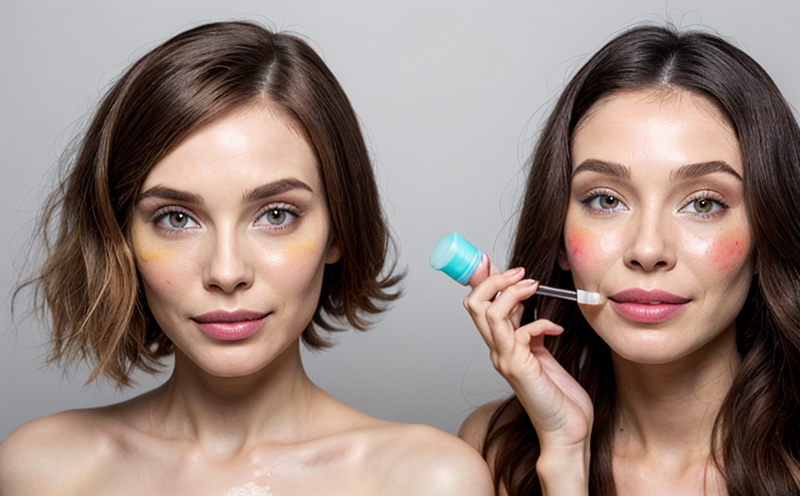Antioxidant Capacity Testing of Botanical Cosmetics
The antioxidant capacity testing of botanical cosmetics is a critical step in ensuring that products meet regulatory standards and deliver effective protection against oxidative stress. This service is particularly important for natural and organic cosmetic product developers, as it helps them demonstrate the efficacy of their formulations without synthetic antioxidants.
Antioxidants are essential ingredients in cosmetic products, especially those marketed as natural or organic, because they help neutralize free radicals that can damage skin cells and accelerate aging. The antioxidant capacity of botanical extracts is often evaluated using various methodologies, including the DPPH (1,1-diphenyl-2-picrylhydrazyl) assay, ABTS (2,2'-azino-bis(3-ethylbenzthiazoline-6-sulfonic acid)) radical cation decolorization assay, and FRAP (Ferric Reducing Antioxidant Power) assay.
The testing process involves the extraction of active compounds from botanical materials and their subsequent evaluation for their ability to scavenge free radicals. This is typically done by measuring the reduction in absorbance of a colored radical solution after adding an antioxidant-containing sample. The results are expressed as Trolox equivalents (TE) or as percentage inhibition, which allows for direct comparison with reference standards.
Accurate and reliable testing ensures that products not only meet regulatory requirements but also perform effectively on the market. Regulatory bodies such as the European Commission’s Cosmetics Regulation (EC No 1223/2009) require cosmetics to be safe, effective, and free from harmful substances. Antioxidant capacity tests are a key component in ensuring compliance with these regulations.
The testing protocol for antioxidant capacity involves several steps:
- Sample preparation: The botanical material is extracted using appropriate solvents (e.g., methanol).
- Dilution: Extracts are diluted to achieve concentrations within the linear range of the assay.
- Assay performance: The extract is added to a solution containing the radical, and absorbance changes over time are measured.
- Data analysis: The results are compared against calibration curves or reference standards to determine antioxidant capacity.
The use of high-performance liquid chromatography (HPLC) can also be employed for more detailed profiling of antioxidants present in the botanical extracts, providing additional insights into the composition and efficacy of the product.
Our laboratory uses advanced analytical instruments such as UV-Vis spectrophotometers and HPLC coupled with diode array detectors to ensure precise measurement. The results are reported alongside relevant standards like ISO 15194:2017, which provides guidelines for testing antioxidants in cosmetics.
Quality and Reliability Assurance
The reliability of antioxidant capacity testing is crucial for maintaining the integrity of cosmetic products. Our laboratory employs stringent quality control measures to ensure consistent and accurate results:
- Calibration: All instruments are regularly calibrated using certified reference materials.
- Laboratory Standard Operating Procedures (SOPs): SOPs are followed rigorously for each step of the testing process, from sample preparation to final data analysis.
- Quality Control Samples: Blinded quality control samples are tested alongside customer samples to verify the accuracy and precision of results.
- Inter-laboratory Comparisons: Our laboratory participates in inter-laboratory comparisons for antioxidant testing, ensuring that our results align with industry standards.
The reliability of antioxidant capacity testing is further enhanced by our commitment to maintaining ISO/IEC 17025 accreditation. This ensures that we meet the highest international standards for technical competence and quality assurance in laboratory testing.
Competitive Advantage and Market Impact
The ability to demonstrate robust antioxidant capacity is a significant differentiator in the natural and organic cosmetic market, where consumer demand for safe and effective products continues to grow. By offering this service, our clients can:
- Enhance Product Safety: Ensure that their products are free from harmful chemicals while still providing effective protection against oxidative stress.
- Increase Market Share: Compete effectively in the rapidly expanding natural and organic market by offering consumers products that meet regulatory requirements and perform as expected.
- Gain Regulatory Compliance: Stay ahead of changing regulations and ensure compliance with international standards such as ISO 15194:2017.
The importance of antioxidant capacity testing cannot be overstated, especially in the context of natural and organic cosmetics. By providing this service, we help our clients create products that not only meet regulatory requirements but also stand out in a competitive market.
Use Cases and Application Examples
The antioxidant capacity testing of botanical cosmetics has numerous applications across the industry:
- New Product Development: Our service helps cosmetic developers identify the most effective antioxidants for their formulations, ensuring that new products meet both regulatory standards and market expectations.
- Formulation Optimization: By understanding the antioxidant capacity of individual ingredients, formulators can optimize product recipes to enhance efficacy without compromising safety.
- Quality Control: Regular testing ensures that finished products consistently meet quality specifications and are free from contaminants or synthetic additives.
- Regulatory Compliance: Our service supports clients in meeting the stringent requirements of regulatory bodies, enhancing their reputation and market position.
A case study involving a major natural cosmetics brand illustrates the value of this testing. The client was developing a new line of botanical-based serums aimed at consumers seeking products with minimal synthetic additives. By using our antioxidant capacity testing service, they were able to identify the most effective antioxidants for their formulations and ensure that these products met international standards without compromising on safety or efficacy.





